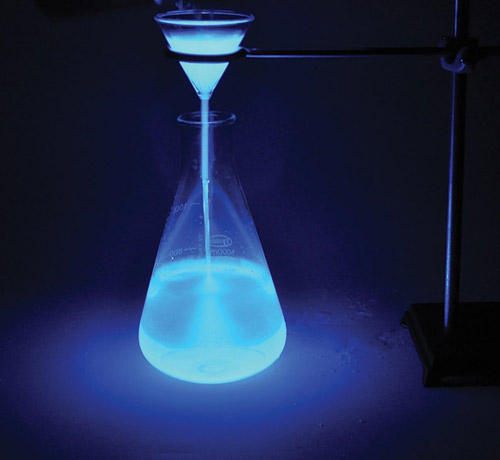luminescence

Chemiluminescence.
Luminescence is the non-thermal emission of electromagnetic radiation, particularly light, from a substance after it has been stimulated in some way other than by high temperatures. In this respect it differs from incandescence. Forms of luminescence include photoluminescence (including fluorescence and phosphorescence), chemiluminescence, bioluminescence, and triboluminescence.
Bioluminescence
Bioluminescence is the production of light, with very little heat, by a chemical reaction within an organism.
Chemiluminescence
Chemiluminescence is luminescence caused by a chemical reaction, usually oxidation, as of phosphorus in air. The molecules are excited to a high energy level, and emit light as they return to the ground state. This process, as we've seen, in living organisms is called bioluminescence.
Photoluminescence
Photoluminescence is a type of luminescence produced by the action of photons, such as those in infrared, visible or ultraviolet light or in X-rays or gamma rays. Luminescence produced by the action of electrons is known as electroluminescence.
Electroluminescence
Electroluminescence is the emission of light from some phosphors (particularly zinc sulfide, ZnS) and semiconductors under the influence of an applied electric field. Electrophotoluminescent screens (in which the effect is photon activated) are used medically to intensify X-ray pictures. Part of the light from a fluorescent light is due to electroluminescence, the rest is due to photoluminescence.
Fluorescence
Fluorescence is a form of luminescence in which a substance emits visible light almost immediately after it has been stimulated or excited by electromagnetic radiation of a different wavelength or by certain other means.
Phosphorescence
Phosphorescence is a form of luminescence in which a substance emits visible light some time after it has been stimulated or excited by electromagnetic radiation of a different wavelength or by certain other means not involving a rise in temperature. The light is given off within a period arbitrarily set at greater than 10 nanoseconds (10-8 second) – after the stimulation ends; in this respect, the phenomenon differs from fluorescence. The slower time scales of the re-emission of the radiation are associated with quantum mechanically forbidden energy state transitions. Phosphorescence is the mechanism used for "glow in the dark" materials which need to be charged up by exposure to light.
Thermoluminescence
Thermoluminescence is the emission of light from a steadily heated material that has previously been exited by exposure to radiation. It is a form of luminescence and arises from electron displacements within the material's crystal lattice. A long time delay may elapse between excitation and subsequent light emission; this is utilized in thermoluminescent dating in archaeology.
Triboluminescence
Triboluminescence is a form of luminescence caused by adding mechanical energy to certain substances by rubbing, scratching, striking, or crushing.


